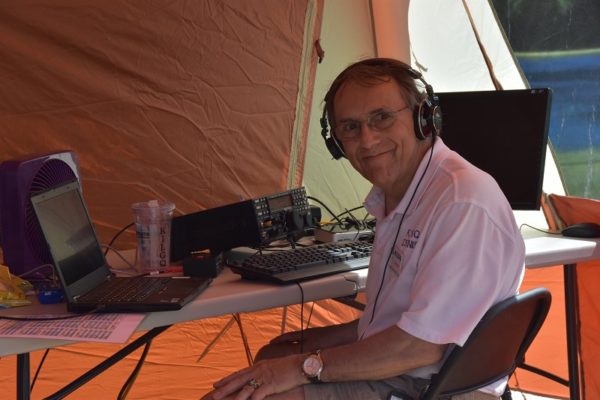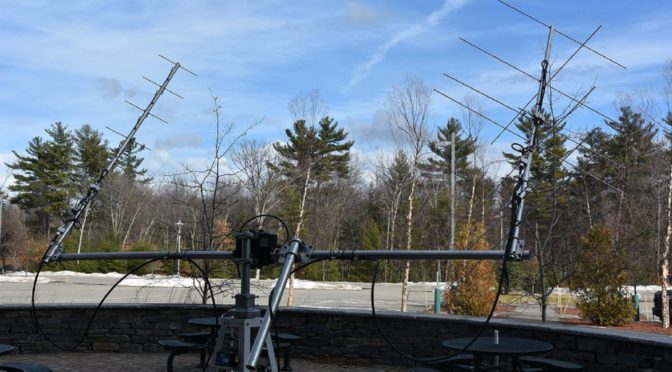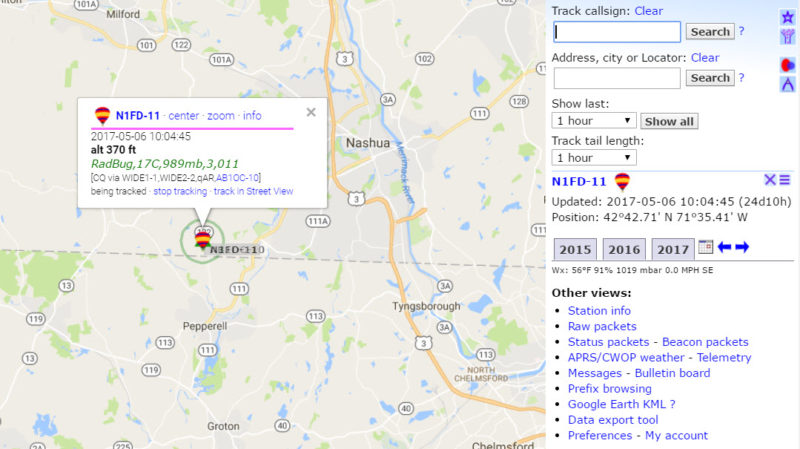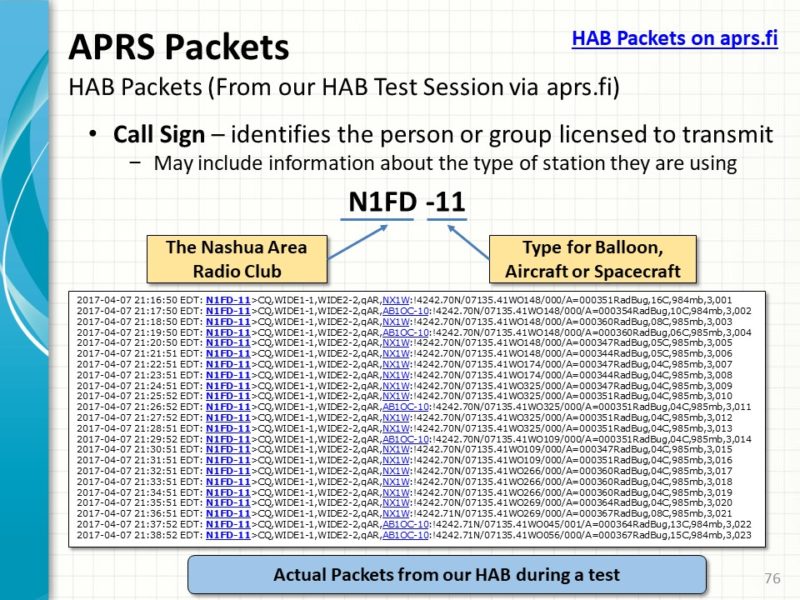MT. HALE and 30 METERS QRP
The White Mountains National Forest
Dennis Marandos – K1LGQ
The trip to the mountain had been planned four weeks in advance and I was to guide my seventeen-year-old son, Justin and his two friends, on a Saturday hike in the White Mountains in northern New Hampshire. The date was May 27th and it was agreed that I would bring along my radio gear because I am the driver and the guy who knows how to climb Mt. Hale. It was agreed that Justin wouldn’t complain when I took an hour off from our climb for me to string a dipole and work some DX just waiting for my QRP signal east and westward wound. My son with his two friends packed into dad’s car and headed due north driving one hundred twenty miles to the White Mountains National Forest. For those people who are unfamiliar with the North Country, New Hampshire has a great number of mountains along with the other five New England states, and NH, in fact, has forty-eight foothills that are 4,000 feet or better. This may seem quite mundane, however, hiking and “hill topping” with a handy on these ridges is “primo” in this part of the country.
The gang arrived at Zealand trail, Halebrook & Lend-A-Hand trails at 9:15 ready to zoom up the miles of pure fun. I had my handy, my 30 meters “30-40” home brew rig with me and a pretty heavy 12-volt gel-cell battery. I knew the kids, who were all 17 years old, would complain if I asked them to carry my gear, so I opted to carry a ‘large’ knapsack with water, small lunch, extra socks, sweatshirt, and long pants by myself. The backpack was pretty heavy, but you have to know what to expect for weather when climbing any mountain. I also had my key, earphones, and dipole in a waterproof bag neatly stored till we reached the top.
As we climbed, the early morning sun was vibrant as in just about any corner of the U.S., but when the clouds started rolling in on our climb at ten in the morning, the weather was truly undefined for that day. Sure, you can listen to the National Weather stations, but the NWS tends to extend their prognostications to include everything, just in case anybody should question their forecasts. The sky was navy blue and the air temperature was a cool 65 degrees—just right. The precipitation was damp from the previous night and we were headed onto an easy climb, and total time to the top was estimated at about two hours or less.
I couldn’t wait till we got to the top of Mt. Hale and do some QRP operating. The boys were twenty feet ahead of me, throughout the entire climb, and they had a much lighter backpack. I kept insisting that they shouldn’t run so often or they would be out of strength by the time they reached the top. Right! I am talking to three teenage boys! That was an exasperation of time.
As we drew nearer the top, you could feel the air turn denser and the temperature dropped a bit more. The tree line was thinning, but never to the point of an overall rock surface. The total height of Mt. Hale is 4,054 feet, and the trail began at the 2,100-foot level. I was psyched about operating from the mountain and kept thinking of how I would set up my portable station. Over and over I kept asking myself which direction way was south and which was west. I wanted especially to work the west coast and Europe if I could
Finally, when the crew was ten feet away from where the old ranger station used to be on top of Mt. Hale, I yelled to the ghosts of the mountain that I was coming, ready or not. I wanted to clear the area and not have something senseless happen like have my RF flow into the absorbing rocks nearby—never to be heard from again. At this moment, the sky had turned pretty gray and the temperature must have dropped another ten degrees since we started our excursion from the base, but worst of all was the intimidating spitting of droplets on my glasses. This was New England, and if you particularly don’t like the weather, just wait a short while and the elements will change. I knew what to do, after all–I am Mr. Cool and a smart Dad. You don’t think for a minute that I would bring my son and two of his friends on a hike and have the weather turn on us?
The environment factors were increasing and I knew something was up, but I was resolute to get my station up and operating. The boys wanted to eat their lunch first, and being the group leader, I suggested the boys not eat and drink too fast for they might get dizzy after a strenuous climb. Again, I forgot who I was talking to. Out came their bags of Nachos, potato chips, and heavy duty caffeinated Coca Cola along with sugar desserts made with chemicals I couldn’t even pronounce on the side of the bags. Ugh! Give me a break, but I insisted we set up my station real soon, so the boys could walk around a bit while I did some CW.
Fate has a way of presenting farrago weather to the unsuspecting neophyte in the wilds. No sooner did I reach into my knapsack for my radio gear, and no sooner did I uncurl my dipole, it started to RAIN! I mean, this was the mother of all storms and Armageddon was just a warm up. The boys had brought jackets, with rain hoods, while I only had a hand towel, socks, and a sweatshirt. It didn’t look like the rain was going to stop and I motioned to the boys to just sit tight for a few minutes while this ‘bimbo’ rain cloud passed overhead. Fifteen minutes had gone by and the rain was filling anything that could hold moisture. It looked like the hike was a wash and we started down another trail. Yikes! I wanted to operate!
The climb down the mountain is always easier, but nastier because gravity tends to push forward. I instructed the boys to walk slowly so they wouldn’t slip and roll the rest of the way, but there I go again…I forgot who I was talking to. Three teenage boys, who had their fill of whatever chemicals were in their lunch, bouncing down the side of Mt. Hale and having a pretty good time. I kept my vociferation comments within their ear shot and reminded them I had the keys to the car, which was another six miles away. Okay, perhaps a half mile away.
I am pretty sure the troops hadn’t traveled twenty minutes down the mount when the sky opened with beautiful rays of the sun and bright patches of azure blue. I couldn’t believe it! The weather was perfect and here I was going the wrong direction. Great! Do I ask the guys to turn around and head back to the summit so I can do a little CW and have my time, or do I keep going down because they’re running at a gallop and I am not? Superfluous to say, we kept descending more and more, side-stepping the six-inch puddles of water and four foot wide streams in our path.
After we got to the car and unpacked our gear from our backpacks, my son and his two friends said they had a remarkable time climbing the mountain and asked if they could do it again…if I wanted to take them. They even gestured that they would carry my gear next time. I gasped for breath and managed to grin from ear-to-ear and said, “You’re on!”
What I thought was a hike into hell, a death march straight up, the torture of climbing a wet mountain—the boys thought was a pretty COOL episode. What other dads would have bothered to take the ‘guys’ onto a mountain, have twenty-foot visibility at the top and gracefully become thoroughly soaked? They had fun, but it bordered on what the definition of fun was. I had to say I sure did miss operating at 4,054 feet on 30 meters, but they did say they would carry my gear next time. I hope my marine battery won’t be too heavy for them. YES!
~~~~~~~~~~~~
Post Script: This hike took place a few decades ago and my son is much older now. However, the facts remain and it still lingers in my mind what a “wonderful” day we had despite the little rain that fell. I certainly hope I can “puff” all the way to the top and try again.








